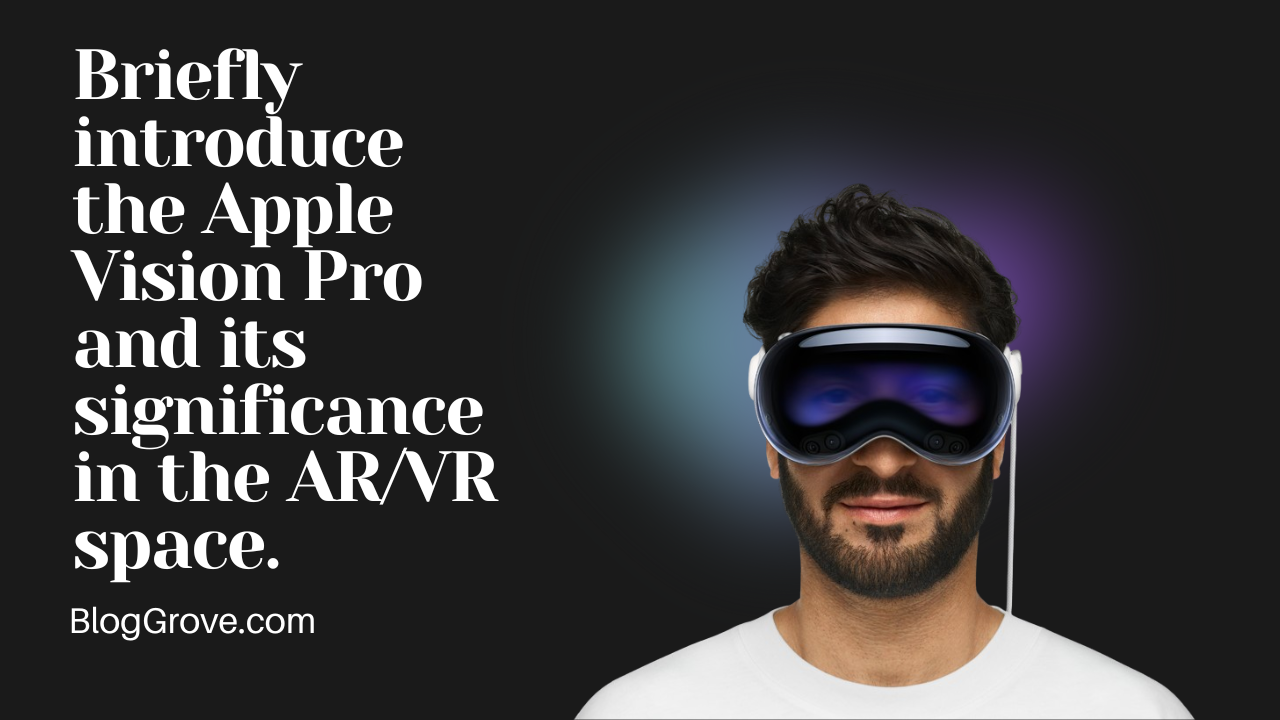Apple Vision Pro: A New Era of Immersive Technology
Apple recently launched its highly anticipated Vision Pro, marking the company’s ambitious entry into the world of augmented reality (AR) and virtual reality (VR). Vision Pro represents more than just a new device — it signals Apple’s commitment to changing how people interact with digital and physical spaces. As Apple’s first major AR/VR headset, Vision Pro combines cutting-edge hardware and seamless software within Apple’s ecosystem, promising an experience that bridges the gap between the virtual and real worlds in ways that previous devices have not achieved.
Vision Pro comes at a time when AR/VR technology is rapidly advancing, and consumer interest is growing across industries from entertainment to education. While many AR/VR headsets focus on gaming or specific applications, Apple’s approach with Vision Pro extends the technology’s reach to productivity, learning, and everyday interactions.
Apple Vision Pro: A New Frontier in AR and VR
Apple’s Vision Pro represents a major leap forward in AR/VR technology by seamlessly integrating the digital world with the physical world. The device is designed not just as an accessory, but as a platform for interacting with virtual content in a way that feels as natural as using a smartphone or computer. Apple is known for its constant forward thinking, and the Vision Pro is a clear extension of that philosophy.
With features like high-quality optics, precise tracking, and a powerful custom chipset, Apple aims to set new standards in AR/VR. Vision Pro aspires to be more than just a novelty or gaming tool — it’s positioned to revolutionize how people use technology in their daily lives, from work and education to social interactions and beyond.
Key Features of Apple Vision Pro
What sets Vision Pro apart is its combination of advanced hardware and intuitive software. Apple’s ecosystem offers a level of seamless integration that makes Vision Pro a natural extension of existing Apple devices. Here’s a closer look at some of the standout features:
Advanced Display: Vision Pro features high-resolution displays that bring stunning clarity to virtual environments, allowing for detailed and lifelike visuals.
Eye Tracking and Gesture Recognition: Enhanced tracking features allow Vision Pro to respond to subtle gestures and eye movements, creating an intuitive experience.
Spatial Audio: To enhance immersion, Apple includes spatial audio that adjusts sound based on head movement, adding realism to virtual interactions.
Apple’s custom chipset: Vision Pro is powered by a high-end chipset that ensures smooth performance, even when running more demanding applications.
The hardware that powers Vision Pro.
Apple’s Vision Pro doesn’t rely solely on software to deliver an immersive experience. It’s backed by some of the most powerful hardware in the AR/VR space. A key element is its high-resolution display system, which delivers incredibly high-fidelity visuals. Apple has designed this display to be comfortable for extended use, reducing issues like motion sickness that can often accompany VR experiences.
The Vision Pro’s custom chipset, like Apple’s popular M-series chips, supports complex tasks like real-time rendering and advanced machine learning, while maintaining battery performance. This combination of performance and power efficiency is rare in the AR/VR industry and positions the Vision Pro as a leader in wearable tech performance.
Revolutionary display and optics
Apple’s Vision Pro is equipped with a custom display that promises incredibly sharp and vibrant visuals, setting it apart from many current-generation headsets. This high-definition display is paired with innovative optical elements, ensuring that every pixel is displayed with precision. Apple has placed a heavy emphasis on visual fidelity, understanding that clear, crisp imagery is crucial to creating a compelling AR/VR experience.
The Vision Pro’s optics have been carefully designed to handle everything from casual virtual meetings to detailed 3D modeling, making it versatile across a range of applications. This display and optics integration sets a new standard for AR/VR and is likely to impress competitors in the industry.
Spatial Audio: A New Dimension in Sound
Audio is often overlooked in AR/VR, but Apple has taken extra care with the Vision Pro’s spatial audio capabilities. With spatial audio, sounds appear to come from specific locations, adapting to your head movements and surroundings. This feature is not only valuable in gaming or entertainment, but it also makes activities like virtual meetings or online classes feel more realistic.
Apple’s spatial audio technology dynamically adjusts sound based on the wearer’s movements, helping to create an authentic sense of space and depth in virtual environments. This auditory realism enhances the immersive experience, making users feel as if they are physically present in a virtual environment.
Highlight Apple’s aim to set a new standard in augmented reality technology.
Apple aims to set a new standard in augmented reality (AR) technology with Vision Pro, transforming how people interact with digital content in their physical space. Unlike many existing AR devices, which can feel more like experiments than fully integrated tools, Apple’s Vision Pro is designed to deliver a smooth, seamless experience that feels intuitive and natural to users.
At the heart of this ambition is Apple’s focus on creating technology that not only overlays digital images on the real world, but does so in a way that is highly realistic and engaging. Apple achieves this by combining an ultra-high-resolution display with precise spatial audio, making digital elements feel tangible and immersive. For example, the Vision Pro’s micro-OLED display is designed to deliver sharp and vibrant visuals, allowing users to perceive depth and detail without the screen-door effect often seen in other AR/VR devices. This emphasis on visual fidelity is consistent with Apple’s broader philosophy of creating products that are not only functional but also visually appealing.
Another aspect of Apple’s approach is its innovative control methods, such as eye tracking, gesture recognition, and voice commands. By focusing on these natural, hands-free interactions, Apple sets a new standard for usability, enabling users to navigate AR environments without the need for complicated controllers or complicated setup. This design approach aims to make AR as accessible as using a smartphone or tablet, removing the intimidating aspects of traditional AR/VR and encouraging wider adoption among everyday users.
Apple’s dedication to creating more immersive AR experiences is also evident in its Vision Pro’s integration with the larger Apple ecosystem. Vision Pro seamlessly connects with other Apple devices, such as iPhones, iPads, and Macs, allowing users to share content, access files, or even collaborate in virtual environments across devices. This integration not only sets Apple apart, but also demonstrates how AR can become a natural extension of existing technology, rather than a stand-alone novelty.
In setting this new standard, Apple is not only enhancing AR for the current moment but also laying the groundwork for the future evolution of AR technology. By setting a high bar for quality, usability, and integration, Apple is leading the industry and inspiring others to innovate, ultimately making augmented reality a more viable, essential part of everyday life.

